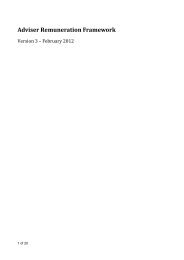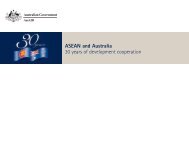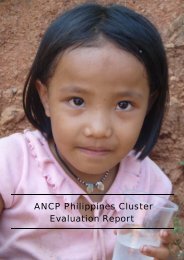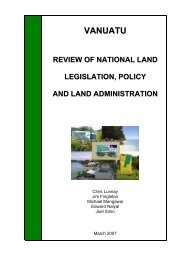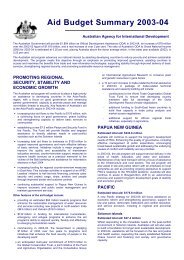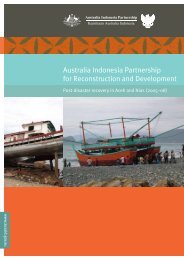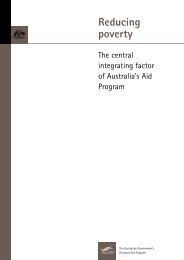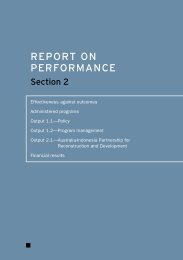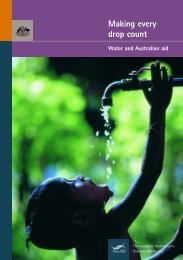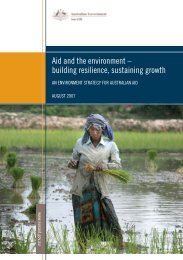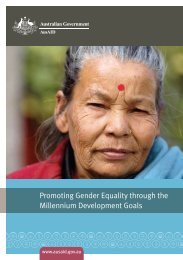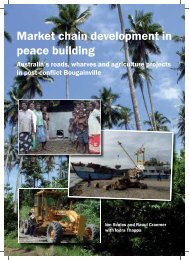Australian Aid to PNG - AusAID
Australian Aid to PNG - AusAID
Australian Aid to PNG - AusAID
You also want an ePaper? Increase the reach of your titles
YUMPU automatically turns print PDFs into web optimized ePapers that Google loves.
BOX 5.5 HEALTH IMPACTS OF AUSTRALIAN ASSISTANCE• Some evidence of a reduction in the number of deaths per 100,000 from malariaand pneumonia between 1996 and 2002, coinciding with increased <strong>Australian</strong>support across the health sec<strong>to</strong>r, including a $9 million project <strong>to</strong> field test an<strong>Australian</strong> candidate malaria vaccine and provide associated training andequipment.• Provided substantial support for immunisation against polio, triple antigen,tetanus <strong>to</strong>xoid, measles, tuberculosis and hepatitis B, including vaccine supplies,helping <strong>to</strong> arrest the decline in immunisation coverage after a fall in rates duringthe mid 1990s.• Immunised over 600,000 children aged under 5 years against polio. Polio has nowbeen eradicated in <strong>PNG</strong>.• Supplied drugs, vaccines and supplies essential <strong>to</strong> treating conditions such asmalaria, pneumonia and diarrhoea <strong>to</strong> over 500 health centres in 20 provinces,including 600 basic medical equipment kits and over 4,000 essential drug kits.• Conducted mobile health clinics and patrols in 8 provinces, immunising childrenagainst tuberculosis, polio and measles and providing antenatal care <strong>to</strong> mothers.• Rehabilitated <strong>PNG</strong>’s vaccine s<strong>to</strong>rage and distribution system.• Trained staff at 40 clinics in HIV/STD testing procedures.• Completed the first Demographic Health Survey in <strong>PNG</strong>, covering 19 provinces.The survey provides a significant database for planning future initiatives inreproductive and population health.• Provided approximately $5 million in goods and associated services, such assurgical equipment and supplies, ward furniture, administrative equipment such ascomputers, and ambulances, and an additional $3 million in biomedicalequipment <strong>to</strong> provincial hospitals.• Completed emergency repairs <strong>to</strong> make medical equipment at 19 provincialhospitals operational.• Reconstructed priority rural health facilities in four provinces, includinginstallation of solar panels, water tanks, water supply lines and bore pumps;renovated general and maternity wards; and constructed or rebuilt housing,<strong>to</strong>ilets, laundries and kitchens.• Upgraded four base hospitals.• Established 20 new provincial vaccine s<strong>to</strong>res, and rehabilitated 222 healthfacilities, including district vaccine s<strong>to</strong>res.• Constructed and equipped 10 new STD clinics.• Improved the level of HIV/AIDS awareness in selected urban and peri-urban areasin <strong>PNG</strong> from 80% <strong>to</strong> 97%, increased condom usage from 35% <strong>to</strong> 42%, andincreased the rate of individuals seeking AIDS tests from 9% <strong>to</strong> 18%.• Mobilised over 150 community and church groups <strong>to</strong> conduct HIV/AIDS awarenessprograms.The Contribution of <strong>Australian</strong> <strong>Aid</strong> <strong>to</strong> Papua New Guinea’s Development 1975–2000 43



